Mastering Instructional Design: A Guide to Effective Learning Experiences
Jun 21, 2023Introduction:
Hey there, welcome to the world of instructional design in the corporate realm! Designing compelling learning experiences for diverse audiences and topics might seem daunting, but fear not! We've got a master formula that can work wonders in any context. In this blog post, we'll explore the Pebble-in-the-Pond Model for Instructional Design and dive into the five first principles of instruction. Get ready to create some seriously impactful instructional designs!
The Pebble-in-the-Pond Model for Instructional Design:
Okay, let's talk about the Pebble-in-the-Pond Model for Instructional Design, brought to you by the genius M. David Merrill. This model is the superhero of instructional design because it's built on five interrelated principles that can tackle any learning challenge. Seriously, it's like a Swiss Army knife for instructional design!
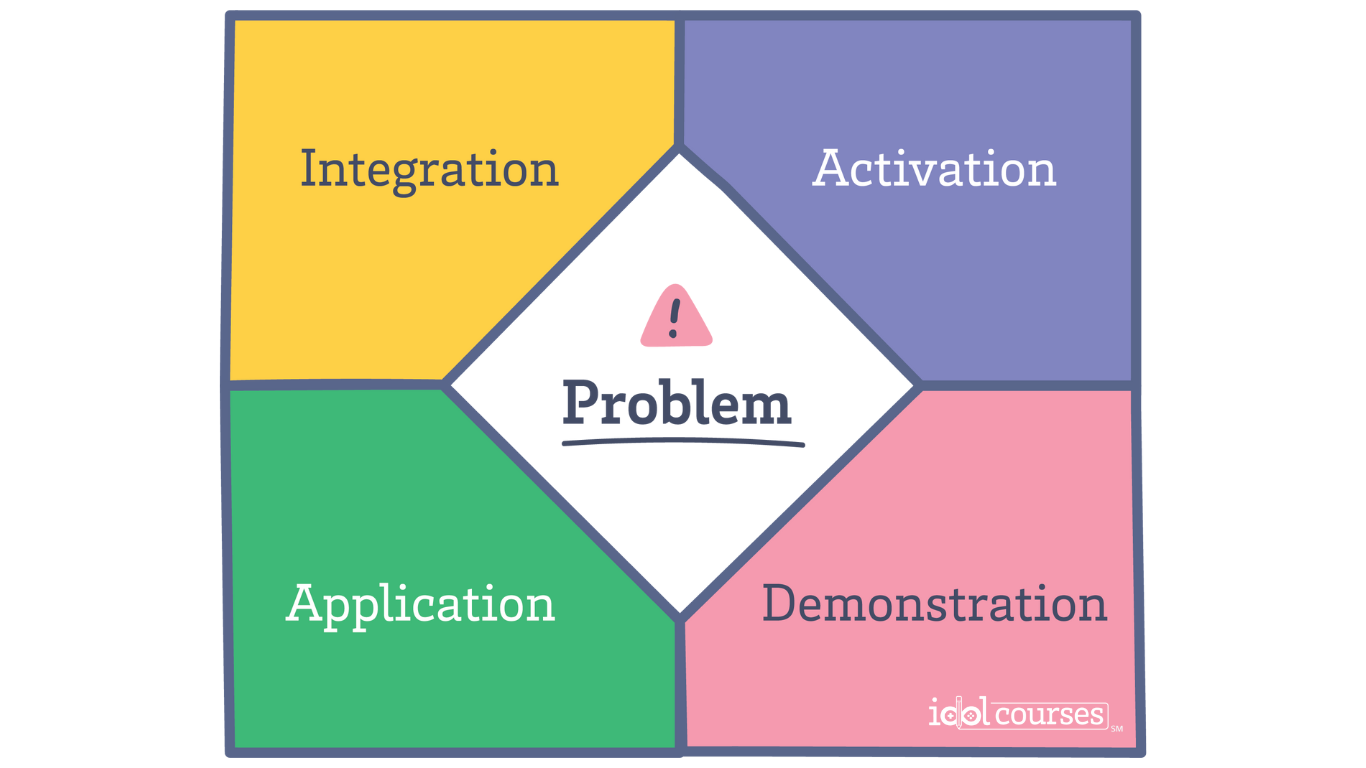
The Five First Principles of Instruction:
Activation Principle: Supercharge Learning with Prior Knowledge

Imagine activating learners' prior knowledge like a superhero power-up! We'll show you how to tap into learners' existing knowledge and help them organize it with new skills. It's all about connecting the dots and making learning effective. We'll teach you how to relate further information to what learners already know and guide them to summarize and connect concepts for solid understanding. Across a range of topics.
Here are eight ways you can activate learners' prior knowledge:
- Use real-life examples and personal stories to activate prior knowledge.
- Ask comprehension questions, not recall questions or memory-matching questions. You'll get better results with the latter two methods, but your audience will need help understanding their differences! So ask what they just learned instead of what they already know about it--you get great insights from that! For instance, instead of asking, "What is the significance of ?" ask, "What do you think would have happened if Napoleon had captured Moscow?"
- Ask them what they already know about a topic, then have them explain it to you.
- Ask them their opinions, or get their reactions to an example.
- Challenge your audience with an open-ended question that requires a lot of thinking and creativity--this is the best method for activating prior knowledge!
- Have your learner share an insight or quote from a text or article related to the topic.
- Use visual reminders of prior knowledge: pictures, famous people, symbols related to the subject, etc.
- Get them to tell you what they've learned from the text before you ask them a question about it. It's incredible how much they'll retain if they talk about it!
Task-Centered Principle: Let's Get Down to Business!
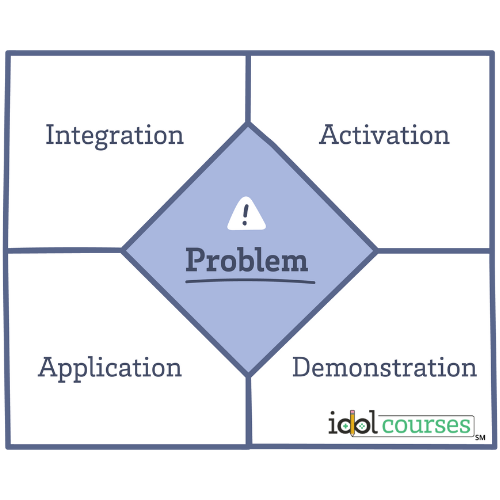
Who needs boring lectures when we can dive into hands-on, task-centered instruction? The Task-Centered Principle is about getting down to business and providing learners with practical, actionable learning experiences. Gone are the days of passive listening and information overload. Instead, we'll focus on breaking down complex tasks into manageable steps, skills, and conditions.
Imagine your learners as aspiring professionals eager to acquire and apply new skills in real-life scenarios. You'll ignite their motivation and enthusiasm by presenting them with demonstrations and real-world applications that directly align with the tasks they'll encounter. They'll develop their skills and knowledge while gaining the confidence to tackle challenges head-on.
To implement the Task-Centered Principle effectively, consider these key steps:
- Identify the target tasks: Define the tasks your learners need to master. Break them into smaller, achievable, easily practiced, and assessed components.
- Design task-specific activities: Develop activities and simulations that mirror real-world situations and allow learners to apply the skills they're acquiring. Provide step-by-step guidance, allowing them to build their competence gradually.
- Provide contextualized examples: Showcase examples and case studies demonstrating the relevance and applicability of the skills taught. Connect theory to practice and help learners understand how the tasks relate to their professional lives.
- Offer scaffolding and support: Offer support and guidance throughout the learning process. Provide resources, tools, and feedback to assist learners as they navigate the tasks and develop their proficiency.
- Promote reflection and debriefing: Encourage learners to reflect on their performance and analyze their strengths and areas for improvement. Facilitate debriefing sessions where they can discuss their experiences, exchange insights, and learn from one another.
Adopting the Task-Centered Principle will create a dynamic learning environment that engages learners and prepares them for real-world challenges. Hands-on experiences and practical applications foster skill development and promote long-term retention. So, let's roll up our sleeves and prepare to empower learners to become professionals in their fields!
Demonstration Principle: Lights, Camera, Action!

Lights, camera, action! Demonstrations are like blockbuster movies for learners, captivating their attention and immersing them in the learning experience. This section will explore how learners can benefit from watching demos that align with their learning content. Get ready to discover the power of demonstration and how it can enhance the learning process.
One of the critical advantages of demonstrations is their ability to provide visual and auditory cues that engage multiple senses simultaneously. By showcasing concept classification, procedure execution, and consequence prediction through well-crafted demos, learners can grasp complex ideas more effectively. They witness applying theoretical knowledge practically and tangibly, bridging the gap between abstract concepts and real-world scenarios.
To make the most of the Demonstration Principle, here are some tips to keep in mind:
- Concept classification: Identify and classify the core concepts that must be demonstrated. Break down complex ideas into smaller, more digestible parts, and highlight their key features. This will help learners understand the underlying principles and how they relate to the broader context.
- Procedure execution: Demonstrate step-by-step procedures, emphasizing the correct sequence and techniques. Pay attention to essential details, such as safety precautions or best practices, that learners should observe when executing the task themselves. This visual guidance and modeling can significantly enhance their understanding and skill acquisition.
- Consequence prediction: Illustrate the potential outcomes and consequences of different actions or decisions. Show learners how their choices can impact the final results and encourage them to make connections between cause and effect. This approach fosters critical thinking and helps learners better understand the subject matter.
- Multiple scenarios: Present learners with diverse scenarios and examples that showcase the versatility and application of the demonstrated concepts. This variety allows learners to recognize patterns, identify commonalities across different situations, and adapt their knowledge to various contexts.
Following these guidelines and offering learners the red-carpet treatment through engaging demonstrations will create an immersive learning experience that leaves a lasting impact. Visuals and practical applications can be compelling in facilitating comprehension and retention. So, let's roll out the figurative red carpet and bring the learning content to life through captivating demonstrations that captivate and inspire our learners!
Application Principle: Applying Knowledge for Superhero-Level Learning
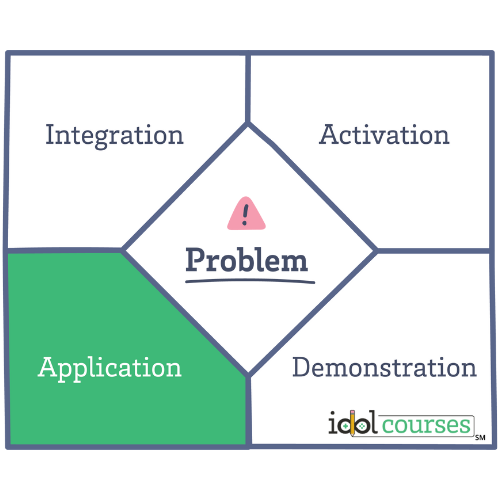
The Application Principle takes learning to new heights by emphasizing the practical application of knowledge and skills. It goes beyond simply acquiring information and focuses on empowering learners to become real-life superheroes in their chosen domains.
To make the most of the Application Principle, we will implement the following strategies:
- Real-world scenarios: We will present learners with authentic, real-world scenarios that mirror their challenges in their field of interest. Learners can apply their knowledge and skills in contextually relevant situations by bridging the gap between theory and practice. This approach enhances their understanding of how concepts and skills translate into practical solutions.
- Problem-solving activities: Engaging learners in problem-solving activities sharpens their critical thinking and analytical skills. We will design activities that require learners to analyze complex problems, identify potential solutions, and apply their knowledge to propose effective strategies. These activities encourage learners to think creatively, develop their problem-solving abilities, and build confidence in their decision-making skills.
- Collaborative projects: Collaboration is a crucial component of real-world applications. We will facilitate group projects encouraging learners to work together, leveraging their collective knowledge and skills. Through collaborative problem-solving, learners can explore different perspectives, exchange ideas, and learn from each other's experiences. This fosters teamwork, communication, and the ability to collaborate effectively—a valuable skill in many professional settings.
- Feedback and reflection: Timely and constructive feedback is essential for continuous improvement. As learners engage in application-based tasks, we will provide personalized feedback highlighting their strengths and growth areas. This feedback loop encourages learners to reflect on their performance, adjust, and refine their understanding and skills. It also catalyzes self-directed learning, empowering learners to take ownership of their progress.
- Transferable skills: Besides subject-specific knowledge, we will emphasize developing transferable skills. These skills can be applied across various domains, such as critical thinking, problem-solving, communication, and adaptability. By cultivating these skills, learners excel in the specific application and become agile learners capable of tackling new challenges in diverse contexts.
By embracing the Application Principle, we aim to empower learners to become confident, competent, and agile problem solvers. By providing opportunities for practical application, fostering collaboration, and delivering timely feedback, learners can truly harness the power of knowledge and transform into real-life superheroes in their fields of interest. Together, let's unlock their full potential and embark on an exciting practical learning and discovery journey.
Integration Principle: Take Learning Beyond the Training Room
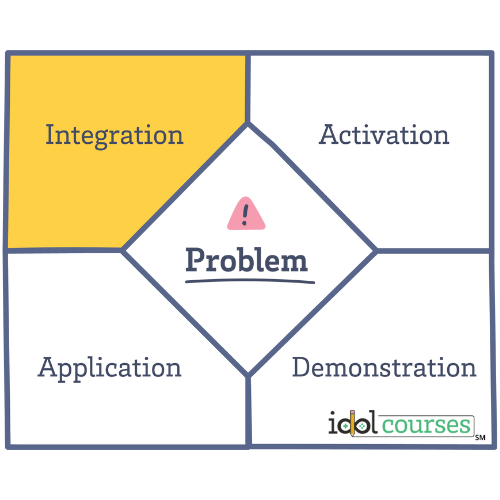
The Integration Principle extends learning beyond the confines of the classroom, fostering a seamless integration of knowledge and skills into learners' everyday lives. By implementing effective integration strategies, we can enhance the retention and practical application of the acquired skills, ensuring learners can effortlessly apply them in various contexts.
To facilitate integration, we will employ the following strategies:
- Discussions and knowledge sharing: Engaging learners in discussions and promoting knowledge-sharing sessions allows them to participate in learning actively. We create a dynamic learning environment that encourages collaboration and exchanging ideas by providing opportunities for learners to express their thoughts, ask questions, and share their insights. These interactions stimulate deep thinking, facilitate a deeper understanding of the subject matter, and enable learners to connect concepts with real-life experiences.
- Deep reflection: Reflection is a powerful tool for integration. We will encourage learners to reflect on their learning experiences, analyze their progress, and consider how they can apply their skills in practical situations. Guided reflection activities will prompt learners to think critically about their learning journey, identify areas for improvement, and make connections between what they have learned and their own personal and professional contexts. This reflective practice enhances metacognitive skills, allowing learners to become more self-aware and intentional in their learning.
- Mental model refinement: Integrating new skills requires learners to adjust their mental models or frameworks of understanding. We will guide learners in evaluating and refining their mental models, helping them align their performance with the newly acquired knowledge and skills. Learners will develop a more comprehensive and accurate mental representation of the subject matter through concept mapping, analogies, and real-life examples. This process of mental model refinement strengthens their ability to apply their skills effectively in diverse situations.
- Contextual application: Integration is most effective when learners can apply their skills in relevant and authentic contexts. We will design activities and projects that mirror real-life situations, encouraging learners to transfer their knowledge to practical scenarios. By aligning learning tasks with the learners' personal and professional contexts, we ensure their acquired skills are directly applicable and meaningful. This approach promotes a sense of relevance and motivation, as learners can see the immediate value of what they are learning.
- Continuous reinforcement: Integration is an ongoing process, and constant support is crucial for long-term retention and application. We will provide opportunities for learners to revisit and reinforce their skills through spaced practice, quizzes, and hands-on activities. Learners solidify their understanding and develop a more robust skill set by reviewing previously learned content and applying it in different contexts.
By embracing the Integration Principle, we enable learners to incorporate their newly acquired skills into their everyday lives seamlessly. Through discussions, deep reflection, mental model refinement, contextual application, and continuous reinforcement, learners will not only retain their knowledge but also become adept at applying it effortlessly whenever and wherever they need to. Let's break down the barriers between eLearning and the real world, ensuring that learning becomes a seamless part of learners' lives.
Conclusion:
Now that you're armed with the Pebble-in-the-Pond Model for Instructional Design and the five first principles of instruction, you're ready to create unforgettable learning experiences for any audience in any context. Activate prior knowledge, create task-centered learning cycles, provide epic demonstrations and applications, and foster integration into learners' everyday lives. In the next part of this blog series, we'll guide you through a quick needs analysis and offer insights on strategically leveraging subject matter experts (SMEs) to develop your course blueprint. Stay tuned for more practical advice on designing mind-blowing learning experiences. Get ready to rock the instructional design world!
Read more about these concepts, look at course examples, and learn how to design instruction in my free PDF version of the book, "The Do It Messy Approach: A Step-by-step Guide for Instructional Designers and Online Learning Developers"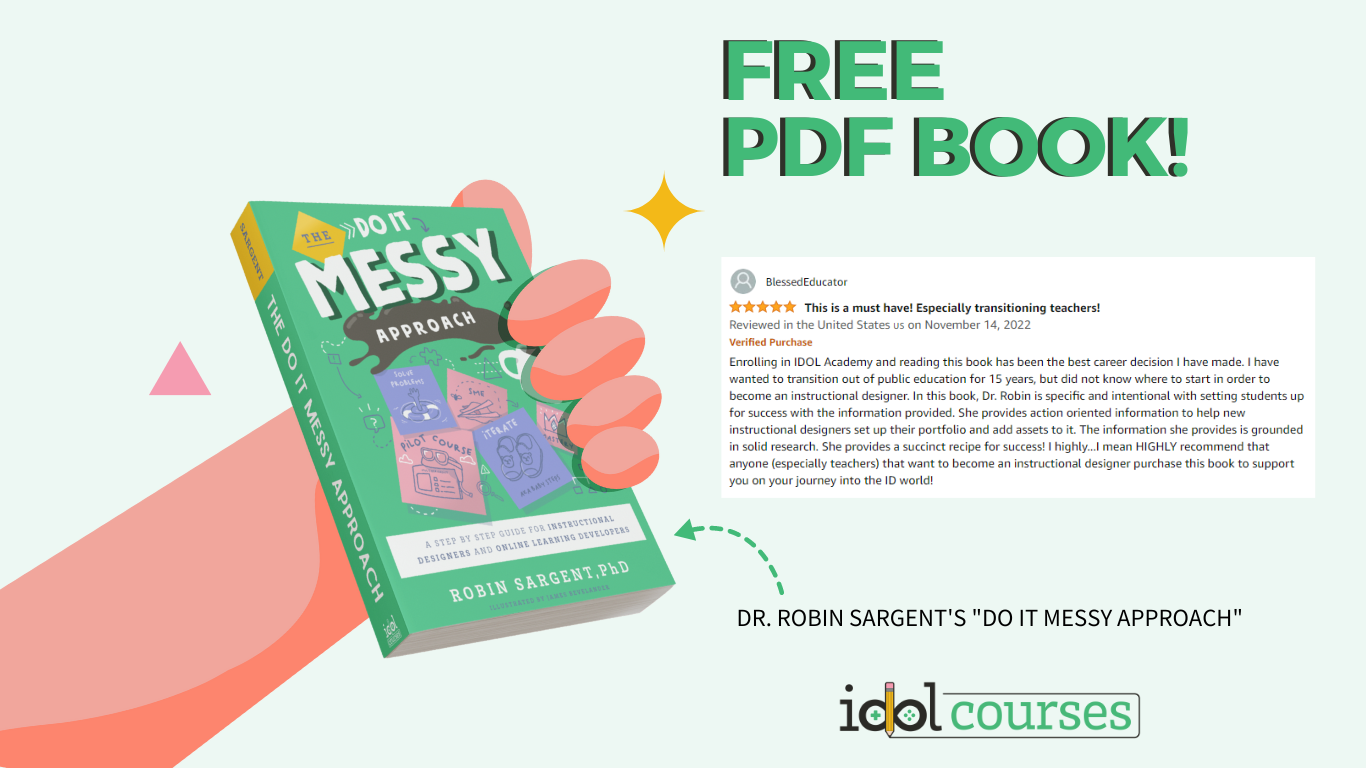
Stay connected with news and updates!
Join our mailing list to receive the latest news and updates from our team.
Don't worry, your information will not be shared.
We hate SPAM. We will never sell your information, for any reason.


